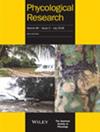Confirmation of Neoporphyra cf. dentata on Shikinejima, Izu Islands, southcentral Japan, and comparison with co‐occurring Neoporphyra haitanensis
IF 1
4区 生物学
Q2 MARINE & FRESHWATER BIOLOGY
引用次数: 0
Abstract
The Izu Islands of southcentral Japan are thought to fall within the distribution range of Neoporphyra dentata. However, the gametophytic blades of Bangiales collected from Shikinejima and Hachijojima, Izu Islands, were identified as Neoporphyra haitanensis in our previous study. Thus, it became uncertain whether N. dentata is distributed in the Izu Islands, including Shikinejima. To clarify whether N. dentata grows on Shikinejima, we conducted a further distribution survey of N. dentata on the island. The morphological features of the blade samples collected from an additional sampling site on Shikinejima were more similar to those of N. dentata than to those of N. haitanensis: the blade thickness and the division formula of spermatangia resembled those of the former species rather than the latter species. However, the division formula of zygotosporangia was different from those of either species. The phylogenetic analyses of the rbcL gene indicated that the samples were resolved in a clade including N. dentata collected from Shirahama, Chiba Prefecture, and Enoshima, Kanagawa Prefecture, Honshu, Japan. The p‐distances of the chloroplast rbcL gene and nuclear 18S rRNA also supported identification of the samples as N. dentata. The results demonstrated that N. dentata is also distributed on Shikinejima with co‐occurring N. haitanensis, and that the island materials of the two species are genetically different from other materials of the two species, respectively.日本中南部伊豆群岛岛岛上新鼠海豚的确认(参见dentata),以及与同时发生的海地新鼠海豚比较
日本中南部的伊豆群岛被认为属于齿新鼠藻的分布范围。然而,在我们之前的研究中,从伊豆群岛的志根岛和八重岛采集的Bangiales的配子体叶片被鉴定为坛新鼠藻。因此,齿齿猪笼草是否分布在伊豆群岛(包括志根岛)变得不确定。为了明确齿猪笼草是否生长在岛上,我们对齿猪笼菜在岛上的分布进行了进一步的调查。从石根岛的另一个采样点采集的叶片样本的形态特征与齿猪笼草的形态特征更相似,而与坛猪笼草相似:受精巢的叶片厚度和分裂公式与前一种而非后一种相似。然而,合子孢子虫的分裂公式与任何一种都不同。rbcL基因的系统发育分析表明,这些样本被解析为一个分支,包括千叶县白滨和日本本州神奈川县隐岛的齿猪笼草。叶绿体rbcL基因和细胞核18S rRNA的p距离也支持将样品鉴定为齿猪笼草。结果表明,齿猪笼草也与共生的坛猪笼草分布在石龟岛上,并且这两个物种的岛屿材料分别与这两个种群的其他材料在基因上不同。
本文章由计算机程序翻译,如有差异,请以英文原文为准。
求助全文
约1分钟内获得全文
求助全文
来源期刊

Phycological Research
生物-海洋与淡水生物学
CiteScore
3.60
自引率
13.30%
发文量
33
审稿时长
>12 weeks
期刊介绍:
Phycological Research is published by the Japanese Society of Phycology and complements the Japanese Journal of Phycology. The Journal publishes international, basic or applied, peer-reviewed research dealing with all aspects of phycology including ecology, taxonomy and phylogeny, evolution, genetics, molecular biology, biochemistry, cell biology, morphology, physiology, new techniques to facilitate the international exchange of results. All articles are peer-reviewed by at least two researchers expert in the filed of the submitted paper. Phycological Research has been credited by the International Association for Plant Taxonomy for the purpose of registration of new non-vascular plant names (including fossils).
 求助内容:
求助内容: 应助结果提醒方式:
应助结果提醒方式:


